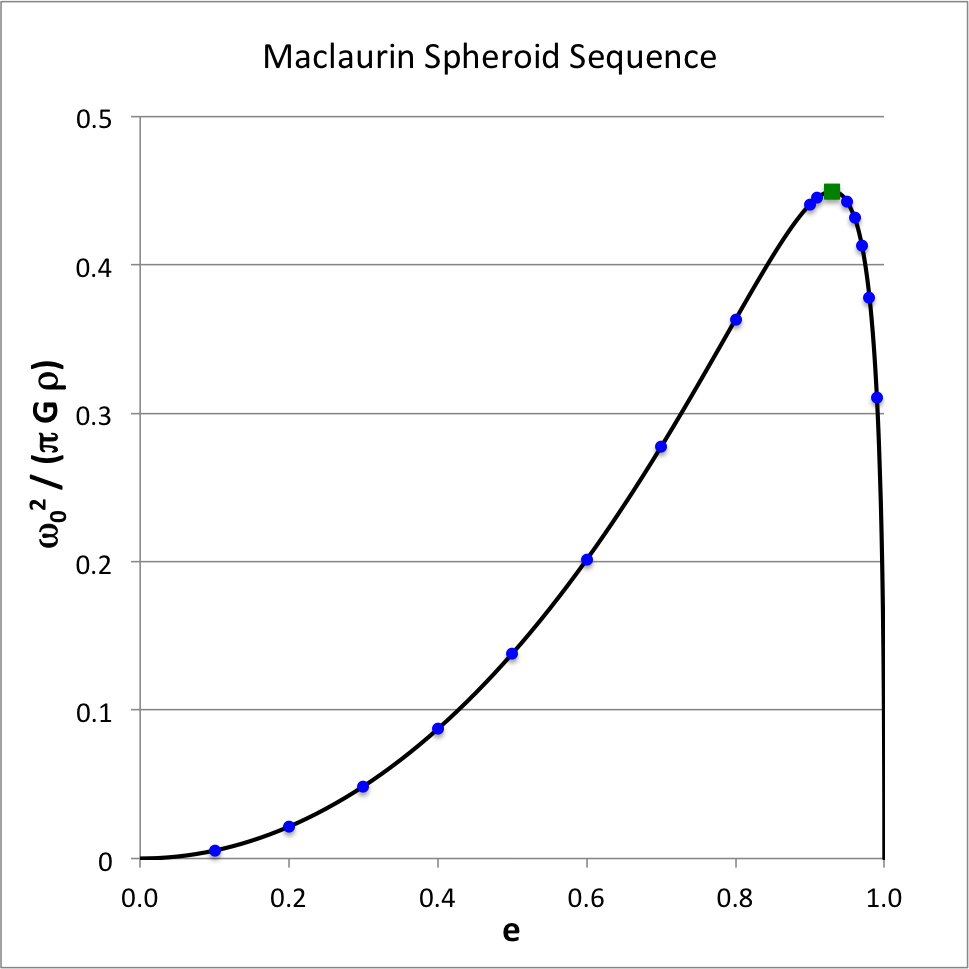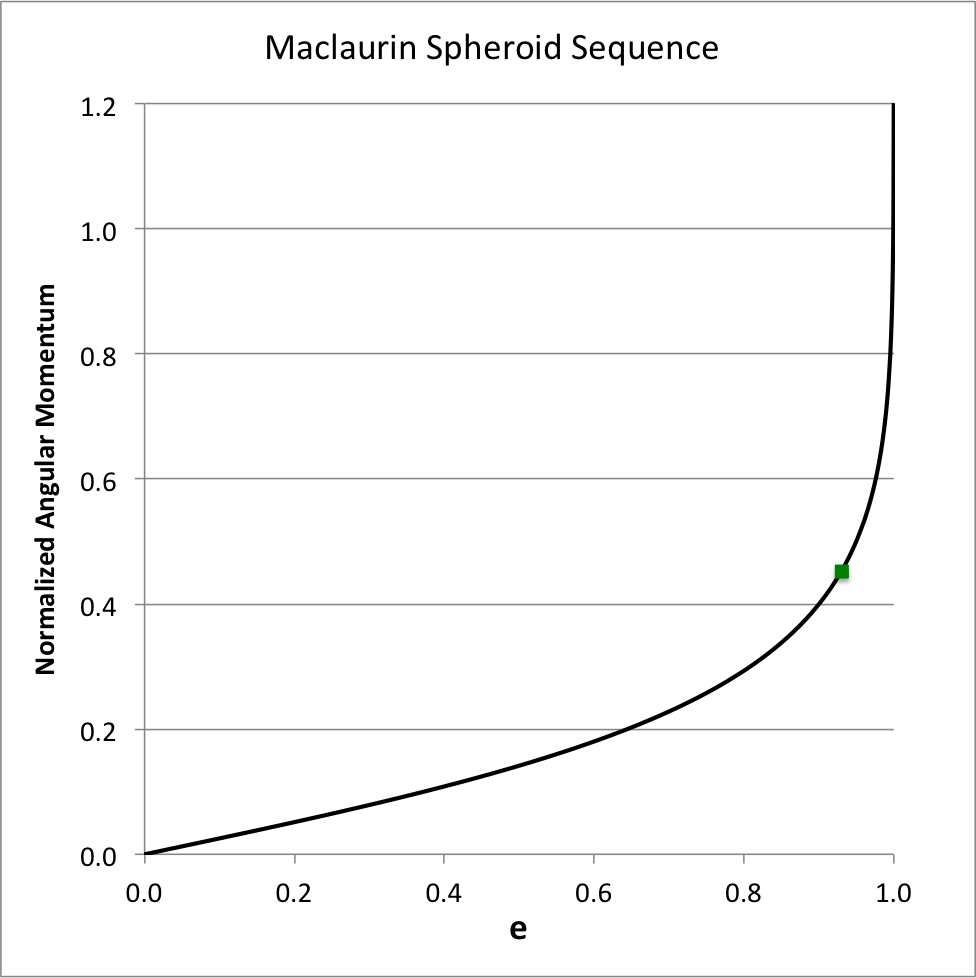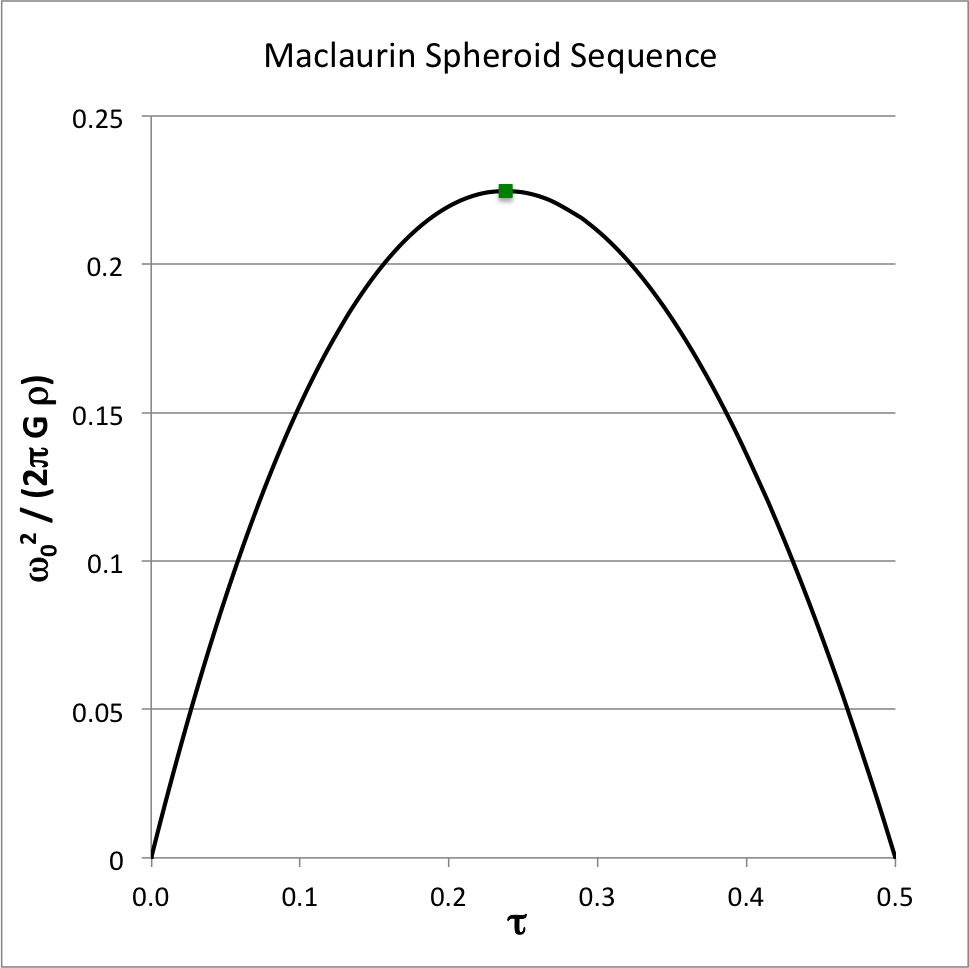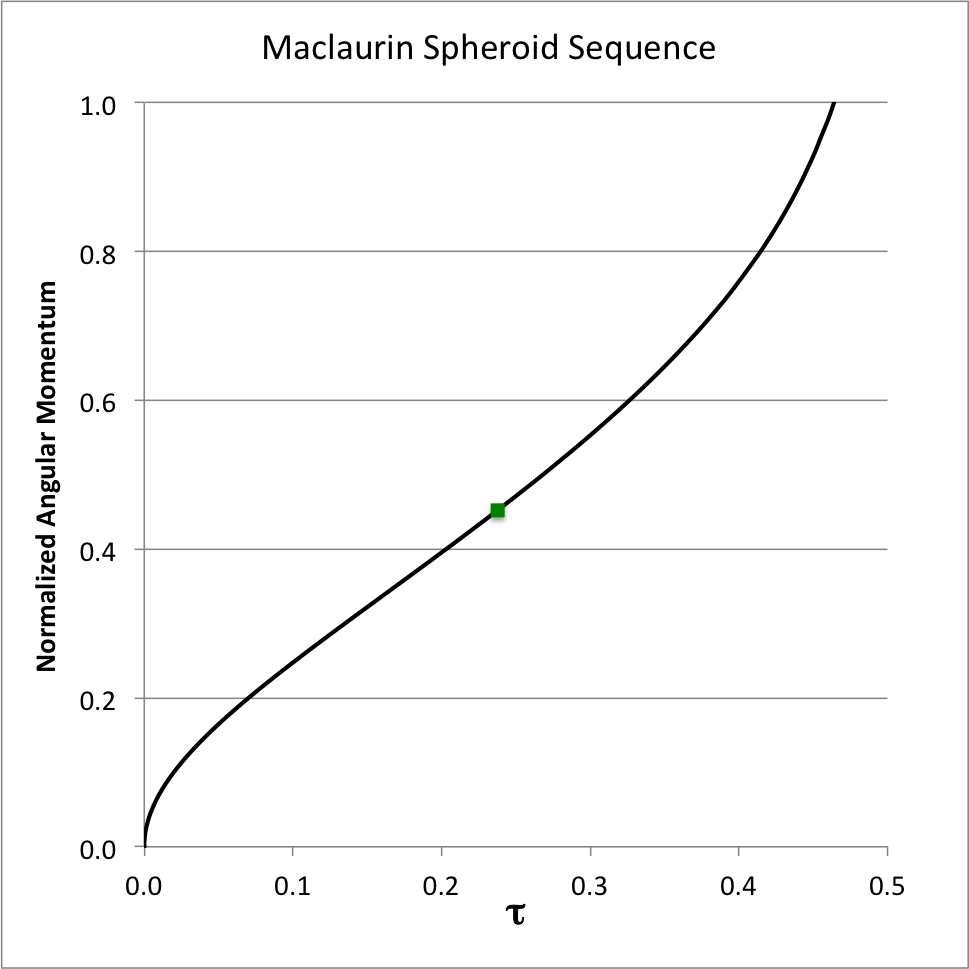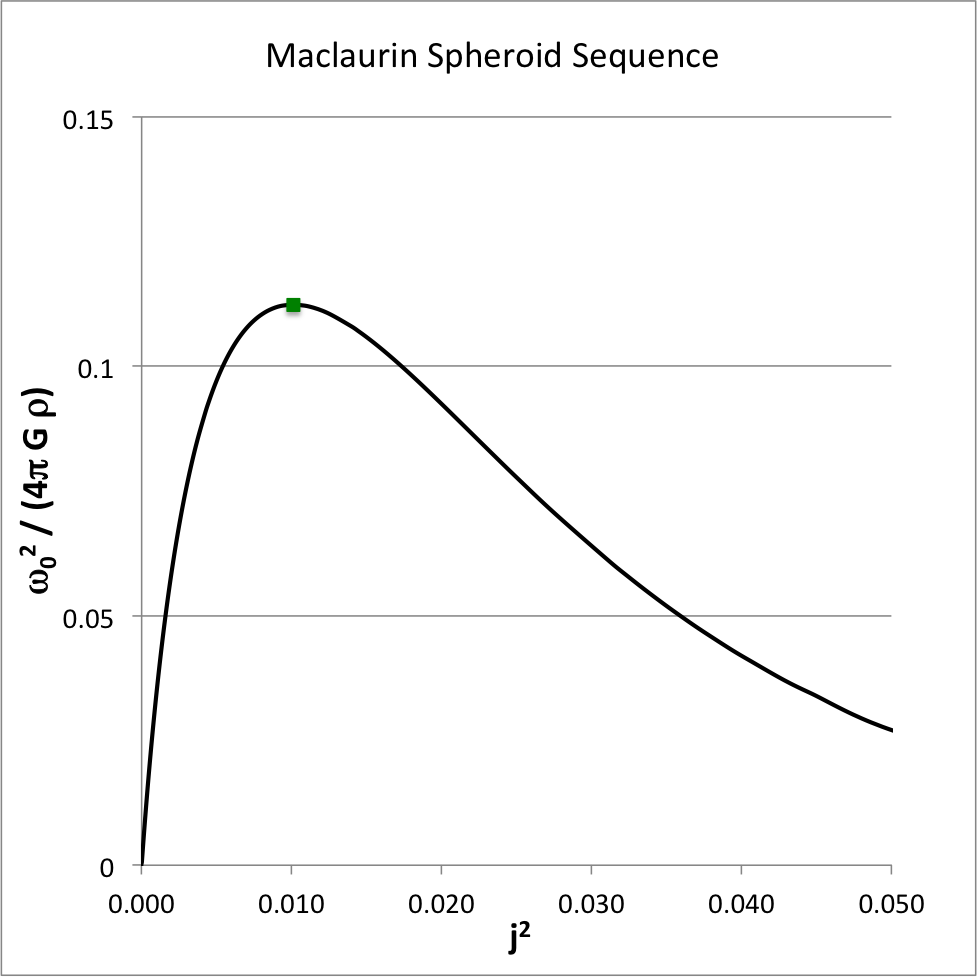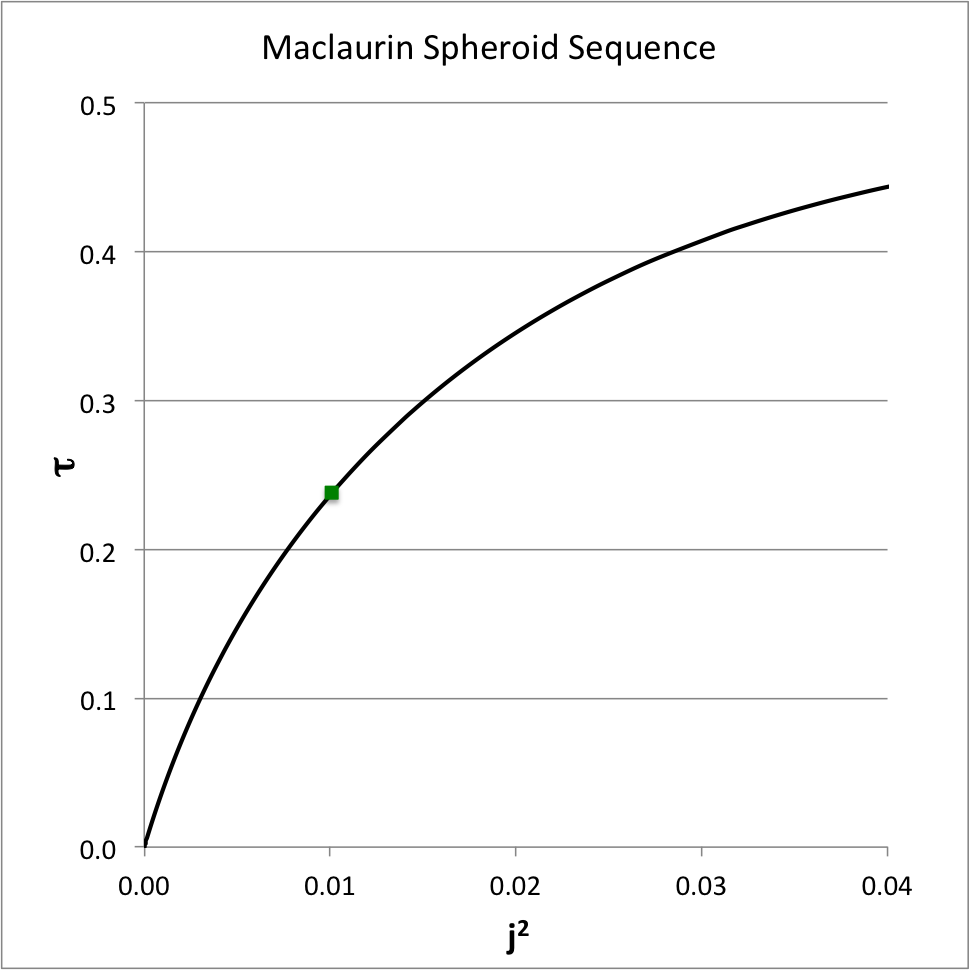Difference between revisions of "User:Tohline/Apps/MaclaurinSpheroidSequence"
| (26 intermediate revisions by the same user not shown) | |||
| Line 8: | Line 8: | ||
==Detailed Force Balance Conditions== | ==Detailed Force Balance Conditions== | ||
<table border="0" align="right" cellpadding="3"> | ===Equilibrium Angular Velocity=== | ||
<table border="0" align="right" cellpadding="3" width="25%"> | |||
<tr> | <tr> | ||
<td align="center">'''Figure 1'''</td> | <td align="center">'''Figure 1'''</td> | ||
</tr> | </tr> | ||
<tr><td align="center"> | <tr><td align="center"> | ||
[[File: | [[File:EFE Omega2vsECCwithThomsonTait2.png|center|350px|Maclaurin Spheroid Sequence]] | ||
</td></tr> | </td></tr> | ||
<tr> | <tr> | ||
<td align="center"> | <td align="center"> | ||
The dark blue circular markers locate 15 of the 18 individual models identified in Table 1. The solid black curve derives from our evaluation of the function, <math>~\omega_0^2(e)</math>; this curve also may be found in: | |||
<div align="center"> | <div align="center"> | ||
Fig. 5 (p. 79) of [<b>[[User:Tohline/Appendix/References#EFE|<font color="red">EFE</font>]]</b>];<br /> | Fig. 5 (p. 79) of [<b>[[User:Tohline/Appendix/References#EFE|<font color="red">EFE</font>]]</b>];<br /> | ||
Fig. 7.2 (p. 173) of [<b>[[User:Tohline/Appendix/References#ST83|<font color="red">ST83</font>]]</b>] | Fig. 7.2 (p. 173) of [<b>[[User:Tohline/Appendix/References#ST83|<font color="red">ST83</font>]]</b>]<br /> | ||
</div> | </div> | ||
</td> | </td> | ||
</tr> | </tr> | ||
</table> | </table> | ||
The essential structural elements of each Maclaurin spheroid model are uniquely determined once we specify the system's axis ratio, <math>~c/a</math>, or | The essential structural elements of each Maclaurin spheroid model are uniquely determined once we specify the system's axis ratio, <math>~c/a</math>, or the system's meridional-plane eccentricity, <math>~e</math>, where | ||
<table border="0" cellpadding="5" align="center"> | <table border="0" cellpadding="5" align="center"> | ||
| Line 61: | Line 63: | ||
</math> | </math> | ||
</td> | </td> | ||
</tr> | |||
<tr> | |||
<td align="center" colspan="3"> | |||
[<b>[[User:Tohline/Appendix/References#EFE|<font color="red">EFE</font>]]</b>], §32, p. 77, Eq. (4)<br /> | |||
[<b>[[User:Tohline/Appendix/References#T78|<font color="red">T78</font>]]</b>], §4.5, p. 86, Eq. (52)<br /> | |||
[<b>[[User:Tohline/Appendix/References#ST83|<font color="red">ST83</font>]]</b>], §7.3, p. 172, Eq. (7.3.18) | |||
</td> | |||
</tr> | </tr> | ||
</table> | </table> | ||
| Line 100: | Line 109: | ||
</math> | </math> | ||
</td> | </td> | ||
</tr> | |||
<tr> | |||
<td align="center" colspan="3"> | |||
[https://books.googleusercontent.com/books/content?req=AKW5QacUcvnNKOrOOLKQN2GwvjqPDiAibFnfefHg5zaZ-Dj2XVOSG4LWJBbv7j_0AJt7oPiYQb7eOefp3WOCgECL3xKX0d1Bkvj3cskOyoFrCyzP5GJ7QmdpbFzpUqqN7Rw4uv_m728lKmQmeVXcZDIApyWkJvCz8iZO3NgH63g_UDdv7oO-o1LLEEEoxicvCzaV_HASALb35u-khvaVKuweb-u1P1q8G49vLIkM6_2tjoWJFTNUMrTr7rngpnlUkaSbku1L_7l- Thomson & Tait (1867)], §522, p. 392, Eqs. (9) & (7)<br /> | |||
[<b>[[User:Tohline/Appendix/References#EFE|<font color="red">EFE</font>]]</b>], §17, p. 43, Eq. (36)<br /> | |||
[<b>[[User:Tohline/Appendix/References#T78|<font color="red">T78</font>]]</b>], §4.5, p. 85, Eqs. (48) & (49)<br /> | |||
[<b>[[User:Tohline/Appendix/References#ST83|<font color="red">ST83</font>]]</b>], §7.3, p. 170, Eq. (7.3.8) | |||
</td> | |||
</tr> | </tr> | ||
</table> | </table> | ||
Figure 1 shows how the square of the angular velocity varies with eccentricity along the Maclaurin spheroid sequence; given the chosen normalization unit, <math>~\pi G\rho</math>, it is understood that the density of the configuration is held fixed as the eccentricity is varied. | |||
<table border="0" cellpadding="10" align="right" width="25%"><tr><td align="right"> | |||
<table border="1" cellpadding="5" align="center"> | |||
<tr> | |||
<td colspan="5" align="center"> | |||
'''Table 1'''<br />Data copied from<br />[https://books.googleusercontent.com/books/content?req=AKW5QacUcvnNKOrOOLKQN2GwvjqPDiAibFnfefHg5zaZ-Dj2XVOSG4LWJBbv7j_0AJt7oPiYQb7eOefp3WOCgECL3xKX0d1Bkvj3cskOyoFrCyzP5GJ7QmdpbFzpUqqN7Rw4uv_m728lKmQmeVXcZDIApyWkJvCz8iZO3NgH63g_UDdv7oO-o1LLEEEoxicvCzaV_HASALb35u-khvaVKuweb-u1P1q8G49vLIkM6_2tjoWJFTNUMrTr7rngpnlUkaSbku1L_7l- Thomson & Tait (1867)], §772, p. 614 | |||
</td> | |||
</tr> | |||
<tr> | |||
<td align="center" width="50%"><math>~e</math></td> | |||
<td align="center"><math>~\frac{\omega_0^2}{2\pi G \rho}</math></td> | |||
<td align="center" bgcolor="lightgrey" rowspan="10"> </td> | |||
<td align="center" width="50%"><math>~e</math></td> | |||
<td align="center"><math>~\frac{\omega_0^2}{2\pi G \rho}</math></td> | |||
</tr> | |||
<tr> | |||
<td align="center">0.10</td> | |||
<td align="center">0.0027</td> | |||
<td align="center">0.91</td> | |||
<td align="center">0.2225</td> | |||
</tr> | |||
<tr> | |||
<td align="center">0.20</td> | |||
<td align="center">0.0107</td> | |||
<td align="center">0.92</td> | |||
<td align="center">0.2241</td> | |||
</tr> | |||
<tr> | |||
<td align="center">0.30</td> | |||
<td align="center">0.0243</td> | |||
<td align="center">0.93</td> | |||
<td align="center">0.2247</td> | |||
</tr> | |||
<tr> | |||
<td align="center">0.40</td> | |||
<td align="center">0.0436</td> | |||
<td align="center">0.94</td> | |||
<td align="center">0.2239</td> | |||
</tr> | |||
<tr> | |||
<td align="center">0.50</td> | |||
<td align="center">0.0690</td> | |||
<td align="center">0.95</td> | |||
<td align="center">0.2213</td> | |||
</tr> | |||
<tr> | |||
<td align="center">0.60</td> | |||
<td align="center">0.1007</td> | |||
<td align="center">0.96</td> | |||
<td align="center">0.2160</td> | |||
</tr> | |||
<tr> | |||
<td align="center">0.70</td> | |||
<td align="center">0.1387</td> | |||
<td align="center">0.97</td> | |||
<td align="center">0.2063</td> | |||
</tr> | |||
<tr> | |||
<td align="center">0.80</td> | |||
<td align="center">0.1816</td> | |||
<td align="center">0.98</td> | |||
<td align="center">0.1890</td> | |||
</tr> | |||
<tr> | |||
<td align="center">0.90</td> | |||
<td align="center">0.2203</td> | |||
<td align="center">0.99</td> | |||
<td align="center">0.1551</td> | |||
</tr> | |||
</table> | |||
</td></tr></table> | |||
In other words, | |||
<table align="center" border="0" cellpadding="5"> | |||
<tr> | |||
<td align="right"> | |||
<math> | |||
~ \frac{\omega_0^2}{2\pi G \rho } | |||
</math> | |||
</td> | |||
<td align="center"> | |||
<math> | |||
~= | |||
</math> | |||
</td> | |||
<td align="left"> | |||
<math> | |||
(3-2e^2)(1-e^2)^{1 / 2} \cdot \frac{\sin^{-1}e}{e^3} | |||
- \frac{3(1-e^2)}{e^2} | |||
\, . | |||
</math> | |||
</td> | |||
</tr> | |||
<tr> | |||
<td align="center" colspan="3"> | |||
[https://books.googleusercontent.com/books/content?req=AKW5QacUcvnNKOrOOLKQN2GwvjqPDiAibFnfefHg5zaZ-Dj2XVOSG4LWJBbv7j_0AJt7oPiYQb7eOefp3WOCgECL3xKX0d1Bkvj3cskOyoFrCyzP5GJ7QmdpbFzpUqqN7Rw4uv_m728lKmQmeVXcZDIApyWkJvCz8iZO3NgH63g_UDdv7oO-o1LLEEEoxicvCzaV_HASALb35u-khvaVKuweb-u1P1q8G49vLIkM6_2tjoWJFTNUMrTr7rngpnlUkaSbku1L_7l- Thomson & Tait (1867)], §771, p. 613, Eq. (1)<br /> | |||
H. Lamb (orig. 1879)], [https://ia902804.us.archive.org/25/items/hydrodynamics00horarich/hydrodynamics00horarich.pdf 2<sup>nd</sup> Ed. (1895)], Ch. XII, §313, p. 583, Eq. (7) — set <math>~\zeta^2 = (1-e^2)/e^2</math><br /> | |||
[https://ui.adsabs.harvard.edu/abs/1886RSPS...41..319D/abstract G. H. Darwin (1886)], p.322, Eq. (14) — set <math>~\gamma = \sin^{-1}e</math><br /> | |||
[https://ui.adsabs.harvard.edu/abs/1928asco.book.....J/abstract J. H. Jeans (1928)], §192, p. 202, Eq. (192.4)<br /> | |||
[<b>[[User:Tohline/Appendix/References#EFE|<font color="red">EFE</font>]]</b>], §32, p. 78, Eq. (6)<br /> | |||
[<b>[[User:Tohline/Appendix/References#ST83|<font color="red">ST83</font>]]</b>], §7.3, p. 172, Eq. (7.3.18) | |||
</td> | |||
</tr> | |||
</table> | |||
Figure 1 shows how the square of the angular velocity varies with eccentricity along the Maclaurin spheroid sequence; given the chosen normalization unit, <math>~\pi G\rho</math>, it is understood that the density of the configuration is held fixed as the eccentricity is varied. | |||
---- | |||
<table border="0" cellpadding="5" width="60%" align="center"><tr><td align="left"> | |||
Examining the Maclaurin spheroid sequence "<font color="orange">… we see that the value of <math>~\omega_0^2</math> increases gradually from zero to a maximum as the eccentricity <math>~e</math> rises from zero to about 0.93, and then (more quickly) falls to zero as the eccentricity rises from 0.93 to unity.</font>" … "<font color="orange">If the angular velocity exceed the value</font> associated with this maximum, "<font color="orange">… equilibrium is impossible in the form of an ellipsoid of revolution. If the angular velocity fall short of this limit there are always two ellipsoids of revolution which satisfy the conditions of equilibrium. In one of these the eccentricity is greater than 0.93, in the other less.</font>"</td></tr> | |||
<tr><td align="right"> | |||
---[https://books.googleusercontent.com/books/content?req=AKW5QacUcvnNKOrOOLKQN2GwvjqPDiAibFnfefHg5zaZ-Dj2XVOSG4LWJBbv7j_0AJt7oPiYQb7eOefp3WOCgECL3xKX0d1Bkvj3cskOyoFrCyzP5GJ7QmdpbFzpUqqN7Rw4uv_m728lKmQmeVXcZDIApyWkJvCz8iZO3NgH63g_UDdv7oO-o1LLEEEoxicvCzaV_HASALb35u-khvaVKuweb-u1P1q8G49vLIkM6_2tjoWJFTNUMrTr7rngpnlUkaSbku1L_7l- Thomson & Tait (1867)], §772, p. 614. | |||
</td></tr></table> | |||
---- | |||
In our Figure 1, the small solid-green square marker identifies the location along the sequence where the system with the maximum angular velocity resides: | |||
<table border="0" cellpadding="5" align="center"> | <table border="0" cellpadding="5" align="center"> | ||
| Line 121: | Line 255: | ||
</table> | </table> | ||
== | ===Corresponding Total Angular Momentum=== | ||
=== | <table border="0" align="right" cellpadding="3"> | ||
<tr> | |||
<td align="center">'''Figure 2'''</td> | |||
</tr> | |||
<tr><td align="center"> | |||
[[File:EFE_AngMomVsEcc.png|center|350px|Maclaurin Spheroid Sequence]] | |||
</td></tr> | |||
<tr> | |||
<td align="center"> | |||
Solid black curve also may be found as: | |||
<div align="center"> | |||
Fig. 6 (p. 79) of [<b>[[User:Tohline/Appendix/References#EFE|<font color="red">EFE</font>]]</b>];<br /> | |||
Fig. 7.3 (p. 174) of [<b>[[User:Tohline/Appendix/References#ST83|<font color="red">ST83</font>]]</b>] | |||
</div> | |||
</td> | |||
</tr> | |||
</table> | |||
The total angular momentum of each uniformly rotating Maclaurin spheroid is given by the expression, | The total angular momentum of each uniformly rotating Maclaurin spheroid is given by the expression, | ||
<table border="0" cellpadding="5" align="center"> | <table border="0" cellpadding="5" align="center"> | ||
| Line 219: | Line 369: | ||
Figure 2 shows how the system's angular momentum varies with eccentricity along the Maclaurin spheroid sequence; given the chosen normalization unit, <math>~(GM^3\bar{a})^{1 / 2}</math>, it is understood that the mass and the volume — hence, also the density — of the configuration are held fixed as the eccentricity is varied. Strictly speaking, along this sequence the angular momentum asymptotically approaches infinity as <math>~e \rightarrow 1</math>; by limiting the ordinate to a maximum value of 1.2, the plot masks this asymptotic behavior. The small solid-green square marker identifies the location along this sequence where the system with the maximum angular velocity resides (see Figure 1); this system is not associated with a turning point along this angular-momentum versus eccentricity sequence. | Figure 2 shows how the system's angular momentum varies with eccentricity along the Maclaurin spheroid sequence; given the chosen normalization unit, <math>~(GM^3\bar{a})^{1 / 2}</math>, it is understood that the mass and the volume — hence, also the density — of the configuration are held fixed as the eccentricity is varied. Strictly speaking, along this sequence the angular momentum asymptotically approaches infinity as <math>~e \rightarrow 1</math>; by limiting the ordinate to a maximum value of 1.2, the plot masks this asymptotic behavior. The small solid-green square marker identifies the location along this sequence where the system with the maximum angular velocity resides (see Figure 1); this system is not associated with a turning point along this angular-momentum versus eccentricity sequence. | ||
==Alternate Sequence Diagrams== | |||
===Energy Ratio, T/|W|=== | ===Energy Ratio, T/|W|=== | ||
| Line 293: | Line 376: | ||
<tr> | <tr> | ||
<td colspan="3" align="center"> | <td colspan="3" align="center"> | ||
'''Table | '''Table 2:''' Limiting Values | ||
</td> | </td> | ||
</tr> | </tr> | ||
| Line 499: | Line 582: | ||
<tr> | <tr> | ||
<td align="center" colspan="3"> | <td align="center" colspan="3"> | ||
[<b>[[User:Tohline/Appendix/References#ST83|<font color="red">ST83</font>]]</b>], §7.3, p. 172, Eq. (7.3.24) | [<b>[[User:Tohline/Appendix/References#ST83|<font color="red">ST83</font>]]</b>], §7.3, p. 172, Eq. (7.3.24)<br /> | ||
[<b>[[User:Tohline/Appendix/References#P00|<font color="red">P00</font>]]</b>], Vol. I, §10.3, p. 489, Eq. (10.54) | |||
</td> | </td> | ||
</tr> | </tr> | ||
</table> | </table> | ||
Building on an [[User:Tohline/Apps/MaclaurinSpheroids#Gravitational_Potential|accompanying discussion of the structure of Maclaurin spheroids]], Table | Building on an [[User:Tohline/Apps/MaclaurinSpheroids#Gravitational_Potential|accompanying discussion of the structure of Maclaurin spheroids]], Table 2 — shown just above, on the right — lists the limiting values of several key functions. Note, in particular, that as the eccentricity varies smoothly from zero (spherical configuration) to unity (infinitesimally thin disk), the energy ratio, <math>~\tau</math>, varies smoothly from zero to one-half. In his examination of the Maclaurin spheroid sequence, [[User:Tohline/Appendix/References#T78|Tassoul (1978)]] chose to use this energy ratio as the ''order parameter'', rather than the eccentricity. | ||
<table border=" | <table border="1" align="center"><tr><td align="center"> | ||
<table border="0" align="center" cellpadding="3"> | <table border="0" align="center" cellpadding="3"> | ||
<tr> | <tr> | ||
<td align="center">'''Figure 3'''</td> | |||
<td align="center" rowspan="3"> </td> | |||
<td align="center">'''Figure 4'''</td> | <td align="center">'''Figure 4'''</td> | ||
</tr> | </tr> | ||
<tr> | <tr> | ||
| Line 526: | Line 609: | ||
Solid black curve also may be found in: | Solid black curve also may be found in: | ||
<div align="center"> | <div align="center"> | ||
Fig. 4.2 (p. 88) & Fig. 10.1 (p. 236) of [<b>[[User:Tohline/Appendix/References#T78|<font color="red">T78</font>]]</b>] | Fig. 4.2 (p. 88) & Fig. 10.1 (p. 236) of [<b>[[User:Tohline/Appendix/References#T78|<font color="red">T78</font>]]</b>] | ||
</div> | </div> | ||
</td> | </td> | ||
| Line 532: | Line 615: | ||
This solid black curve also appears in: | This solid black curve also appears in: | ||
<div align="center"> | <div align="center"> | ||
Fig. 4.2 (p. 88) & Fig. 10.12 (p. 237) of [<b>[[User:Tohline/Appendix/References#T78|<font color="red">T78</font>]]</b>] | Fig. 4.2 (p. 88) & Fig. 10.12 (p. 237) of [<b>[[User:Tohline/Appendix/References#T78|<font color="red">T78</font>]]</b>] | ||
</div> | </div> | ||
</td> | </td> | ||
| Line 539: | Line 622: | ||
</td></tr></table> | </td></tr></table> | ||
Following Tassoul, our Figure 3 shows how the square of the angular velocity varies with <math>~\tau</math>, and our Figure 4 shows how the system angular momentum varies with <math>~\tau</math>. In these plots, respectively, the square of the angular velocity has been normalized by <math>~2\pi G \rho</math> — that is, by a quantity that is a factor of two larger than the normalization adopted in EFE — while the angular momentum has been normalized to the same quantity used in EFE. As above, the small solid-green square marker identifies the location along the sequence where the system with the maximum angular velocity resides. | |||
===Angular Velocity or T/|W| ''vs.'' Angular Momentum=== | |||
Figures 5 and 6, respectively, show how the square of the angular velocity and how the energy ratio, τ, vary with the square of the angular momentum for models along the Maclaurin spheroid sequence. In generating these plots, following the lead of [https://ui.adsabs.harvard.edu/abs/1983PThPh..69.1131E/abstract Eriguchi & Hachisu (1983)], we have normalized the square of the angular velocity by <math>~4\pi G \rho</math> — a factor of four larger than the normalization used in EFE — and we have adopted a slightly different angular-momentum normalization, namely, | |||
<table border="0" cellpadding="5" align="center"> | |||
<tr> | |||
<td align="right"> | |||
<math>~j</math> | |||
</td> | |||
<td align="center"> | |||
<math>~\equiv</math> | |||
</td> | |||
<td align="left"> | |||
<math>~ | |||
\biggl( \frac{3}{2^8 \pi^4} \biggr)^{1/6} \frac{L}{(GM^3\bar{a})^{1 / 2}} \, . | |||
</math> | |||
</td> | |||
</tr> | |||
</table> | |||
<table border="0" align="center" cellpadding="5"><tr><td align="center"> | |||
<table border="0" align="center" cellpadding="3"> | |||
<tr> | |||
<td align="center">'''Figure 5'''</td> | |||
<td align="center" rowspan="3"> </td> | |||
<td align="center">'''Figure 6'''</td> | |||
</tr> | |||
<tr> | |||
<td align="center"> | |||
[[File:EH83Fig3.png|center|350px|Maclaurin Spheroid Sequence]] | |||
</td> | |||
<td align="center"> | |||
[[File:EH83Fig4.png|center|350px|Maclaurin Spheroid Sequence]] | |||
</td> | |||
</tr> | |||
<tr> | |||
<td align="center"> | |||
This solid black curve also appears in: | |||
<div align="center"> | |||
Fig. 3 (p. 1134) of [https://ui.adsabs.harvard.edu/abs/1983PThPh..69.1131E/abstract Eriguchi & Hachisu (1983)]<br /> | |||
Fig. 3 (p. 487) of [https://ui.adsabs.harvard.edu/abs/1986ApJS...61..479H/abstract Hachisu (1986)]<br /> | |||
Fig. 4 (p. 4507) of [https://ui.adsabs.harvard.edu/abs/2019MNRAS.487.4504B/abstract Basillais & Huré (2019)] | |||
</div> | |||
</td> | |||
<td align="center"> | |||
This solid black curve also appears in: | |||
<div align="center"> | |||
Fig. 4 (p. 487) of [https://ui.adsabs.harvard.edu/abs/1986ApJS...61..479H/abstract Hachisu (1986)] | |||
</div> | |||
</td> | |||
</tr> | |||
</table> | |||
</td></tr></table> | |||
As above, the small solid-green square marker identifies the location along both sequences where the system with the maximum angular velocity resides: | |||
<table border="0" cellpadding="5" align="center"> | |||
<tr> | |||
<td align="right"> | |||
<math>~\biggl[ j^2, \frac{\omega_0^2}{4\pi G \rho}, \tau \biggr]</math> | |||
</td> | |||
<td align="center"> | |||
<math>~\equiv</math> | |||
</td> | |||
<td align="left"> | |||
<math>~\biggl[ 0.010105, 0.112333, 0.237894 \biggr] \, .</math> | |||
</td> | |||
</tr> | |||
</table> | |||
=See Also= | =See Also= | ||
Latest revision as of 23:12, 30 July 2020
Maclaurin Spheroid Sequence

|
|---|
| | Tiled Menu | Tables of Content | Banner Video | Tohline Home Page | |
Detailed Force Balance Conditions
Equilibrium Angular Velocity
| Figure 1 |
|
The dark blue circular markers locate 15 of the 18 individual models identified in Table 1. The solid black curve derives from our evaluation of the function, <math>~\omega_0^2(e)</math>; this curve also may be found in: |
The essential structural elements of each Maclaurin spheroid model are uniquely determined once we specify the system's axis ratio, <math>~c/a</math>, or the system's meridional-plane eccentricity, <math>~e</math>, where
|
<math>~e</math> |
<math>~\equiv</math> |
<math>~\biggl[1 - \biggl(\frac{c}{a}\biggr)^2\biggr]^{1 / 2} \, ,</math> |
which varies from e = 0 (spherical structure) to e = 1 (infinitesimally thin disk). According to our accompanying derivation, for a given choice of <math>~e</math>, the square of the system's equilibrium angular velocity is,
|
<math> ~ \omega_0^2 </math> |
<math> ~= </math> |
<math> 2\pi G \rho \biggl[ A_1 - A_3 (1-e^2) \biggr] \, , </math> |
|
[EFE], §32, p. 77, Eq. (4) |
||
where,
|
<math> ~A_1 </math> |
<math> ~= </math> |
<math> \frac{1}{e^2} \biggl[\frac{\sin^{-1}e}{e} - (1-e^2)^{1/2} \biggr](1-e^2)^{1/2} \, , </math> |
|
<math> ~A_3 </math> |
<math> ~= </math> |
<math> \frac{2}{e^2} \biggl[(1-e^2)^{-1/2} -\frac{\sin^{-1}e}{e} \biggr](1-e^2)^{1/2} \, . </math> |
|
Thomson & Tait (1867), §522, p. 392, Eqs. (9) & (7) |
||
| ||||||||||||||||||||||||||||||||||||||||||||||
In other words,
|
<math> ~ \frac{\omega_0^2}{2\pi G \rho } </math> |
<math> ~= </math> |
<math> (3-2e^2)(1-e^2)^{1 / 2} \cdot \frac{\sin^{-1}e}{e^3} - \frac{3(1-e^2)}{e^2} \, . </math> |
|
Thomson & Tait (1867), §771, p. 613, Eq. (1) |
||
Figure 1 shows how the square of the angular velocity varies with eccentricity along the Maclaurin spheroid sequence; given the chosen normalization unit, <math>~\pi G\rho</math>, it is understood that the density of the configuration is held fixed as the eccentricity is varied.
| Examining the Maclaurin spheroid sequence "… we see that the value of <math>~\omega_0^2</math> increases gradually from zero to a maximum as the eccentricity <math>~e</math> rises from zero to about 0.93, and then (more quickly) falls to zero as the eccentricity rises from 0.93 to unity." … "If the angular velocity exceed the value associated with this maximum, "… equilibrium is impossible in the form of an ellipsoid of revolution. If the angular velocity fall short of this limit there are always two ellipsoids of revolution which satisfy the conditions of equilibrium. In one of these the eccentricity is greater than 0.93, in the other less." |
|
---Thomson & Tait (1867), §772, p. 614. |
In our Figure 1, the small solid-green square marker identifies the location along the sequence where the system with the maximum angular velocity resides:
|
<math>~\biggl[ e, \frac{\omega_0^2}{\pi G \rho} \biggr]</math> |
<math>~\equiv</math> |
<math>~\biggl[ 0.92995, 0.449331 \biggr] \, .</math> |
| [EFE], §32, p. 80, Eqs. (9) & (10) | ||
Corresponding Total Angular Momentum
| Figure 2 |
|
Solid black curve also may be found as: |
The total angular momentum of each uniformly rotating Maclaurin spheroid is given by the expression,
|
<math>~L</math> |
<math>~=</math> |
<math>~I \omega_0 \, ,</math> |
where, the moment of inertia <math>~(I)</math> and the total mass <math>~(M)</math> of a uniform-density spheroid are, respectively,
|
<math>~I</math> |
<math>~=</math> |
<math>~\biggl(\frac{2}{5}\biggr) M a^2 \, ,</math> |
and, |
<math>~M</math> |
<math>~=</math> |
<math>~\biggl( \frac{4\pi}{3} \biggr) \rho a^2c \, .</math> |
Hence, we have,
|
<math>~L^2</math> |
<math>~=</math> |
<math>~ \frac{2^2 M^2 a^4}{5^2} \biggl[ A_1 - A_3 (1-e^2) \biggr] 2\pi G \biggl[ \frac{3}{2^2\pi} \cdot \frac{M}{a^2c} \biggr]</math> |
|
|
<math>~=</math> |
<math>~ \frac{6GM^3 {\bar{a}}}{5^2} \biggl[ A_1 - A_3 (1-e^2) \biggr]\biggl(\frac{a}{c}\biggr)^{4/3} </math> |
|
<math>~\Rightarrow ~~~ \frac{L}{(GM^3\bar{a})^{1 / 2}}</math> |
<math>~=</math> |
<math>~ \frac{6^{1 / 2}}{5} \biggl[ A_1 - A_3 (1-e^2) \biggr]^{1 / 2}(1 - e^2)^{-1 / 3} \, ,</math> |
|
where, <math>~\bar{a} \equiv (a^2 c)^{1 / 3} \, .</math> |
||
Figure 2 shows how the system's angular momentum varies with eccentricity along the Maclaurin spheroid sequence; given the chosen normalization unit, <math>~(GM^3\bar{a})^{1 / 2}</math>, it is understood that the mass and the volume — hence, also the density — of the configuration are held fixed as the eccentricity is varied. Strictly speaking, along this sequence the angular momentum asymptotically approaches infinity as <math>~e \rightarrow 1</math>; by limiting the ordinate to a maximum value of 1.2, the plot masks this asymptotic behavior. The small solid-green square marker identifies the location along this sequence where the system with the maximum angular velocity resides (see Figure 1); this system is not associated with a turning point along this angular-momentum versus eccentricity sequence.
Alternate Sequence Diagrams
Energy Ratio, T/|W|
|
Table 2: Limiting Values |
||
|
|
<math>~e=0</math> |
<math>~e=1</math> |
|
<math>~A_1</math> |
<math>\frac{2}{3}</math> |
<math>~0</math> |
|
<math>~A_3</math> |
<math>\frac{2}{3}</math> |
<math>~2</math> |
|
<math>~\frac{\sin^{-1}e}{e}</math> |
<math>~1</math> |
<math>~\frac{\pi}{2}</math> |
|
<math>~\tau \equiv \frac{T_\mathrm{rot}}{|W_\mathrm{grav}|}</math> |
<math>~0</math> |
<math>~\frac{1}{2}</math> |
The rotational kinetic energy of each uniformly rotating Maclaurin spheroid is given by the expression,
|
<math>~T_\mathrm{rot}</math> |
<math>~=</math> |
<math>~ \frac{1}{2}I \omega_0^2 =\frac{Ma^2}{5} \cdot 2\pi G\rho \biggl[ A_1 - (1-e^2)A_3\biggr] </math> |
|
|
<math>~=</math> |
<math>~ \frac{2^3 \pi^2}{3\cdot 5} \cdot G\rho^2 a^4 c \biggl[ A_1 - (1-e^2)A_3\biggr] </math> |
|
|
<math>~=</math> |
<math>~ \frac{2^3\pi^2}{3\cdot 5} \cdot G\rho^2 a^5 \biggl[ \frac{(1-e^2)}{e^3} ~(3 - 2e^2)\sin^{-1}e - \frac{3(1-e^2)^{3 / 2}}{e^2} \biggr] \, ; </math> |
and the gravitational potential energy of each configuration is,
|
<math>~W_\mathrm{grav}</math> |
<math>~=</math> |
<math>~ - \frac{3}{5} \cdot \frac{GM^2}{c} \biggl[ A_1 + \frac{1}{2}(1-e^2)A_3 \biggr] = - \frac{3}{2\cdot 5} \cdot \frac{G}{c} \biggl[ \frac{2^2\pi \rho a^2 c}{3} \biggr]^2 \biggl[ 2A_1 + (1-e^2)A_3 \biggr] </math> |
|
|
<math>~=</math> |
<math>~ - \frac{2^3\pi^2}{3\cdot 5}\cdot G\rho^2 a^4 c \biggl[ 2A_1 + (1-e^2)A_3 \biggr] </math> |
|
|
<math>~=</math> |
<math>~ - \frac{2^4 \pi^2}{3\cdot 5} \cdot G\rho^2 a^5 (1-e^2) \cdot \frac{\sin^{-1}e }{e} \, .</math> |
Hence, the energy ratio,
|
<math>~\tau \equiv \frac{T_\mathrm{rot}}{|W_\mathrm{grav}|}</math> |
<math>~=</math> |
<math>~ \frac{ A_1 - (1-e^2)A_3 }{ 2A_1 + (1-e^2)A_3 } </math> |
|
[T78], §4.5, p. 86, Eq. (53) |
||
|
|
<math>~=</math> |
<math>~ \biggl[ \frac{(1-e^2)}{e^3} ~(3 - 2e^2)\sin^{-1}e - \frac{3(1-e^2)^{3 / 2}}{e^2} \biggr] \biggl[ 2(1-e^2) \cdot \frac{\sin^{-1}e }{e} \biggr]^{-1} </math> |
|
|
<math>~=</math> |
<math>~ \frac{3}{2e^2}\biggl[ 1 - \frac{e(1-e^2)^{1 / 2}}{\sin^{-1} e}\biggr] - 1 \, .</math> |
|
[ST83], §7.3, p. 172, Eq. (7.3.24) |
||
Building on an accompanying discussion of the structure of Maclaurin spheroids, Table 2 — shown just above, on the right — lists the limiting values of several key functions. Note, in particular, that as the eccentricity varies smoothly from zero (spherical configuration) to unity (infinitesimally thin disk), the energy ratio, <math>~\tau</math>, varies smoothly from zero to one-half. In his examination of the Maclaurin spheroid sequence, Tassoul (1978) chose to use this energy ratio as the order parameter, rather than the eccentricity.
|
Following Tassoul, our Figure 3 shows how the square of the angular velocity varies with <math>~\tau</math>, and our Figure 4 shows how the system angular momentum varies with <math>~\tau</math>. In these plots, respectively, the square of the angular velocity has been normalized by <math>~2\pi G \rho</math> — that is, by a quantity that is a factor of two larger than the normalization adopted in EFE — while the angular momentum has been normalized to the same quantity used in EFE. As above, the small solid-green square marker identifies the location along the sequence where the system with the maximum angular velocity resides.
Angular Velocity or T/|W| vs. Angular Momentum
Figures 5 and 6, respectively, show how the square of the angular velocity and how the energy ratio, τ, vary with the square of the angular momentum for models along the Maclaurin spheroid sequence. In generating these plots, following the lead of Eriguchi & Hachisu (1983), we have normalized the square of the angular velocity by <math>~4\pi G \rho</math> — a factor of four larger than the normalization used in EFE — and we have adopted a slightly different angular-momentum normalization, namely,
|
<math>~j</math> |
<math>~\equiv</math> |
<math>~ \biggl( \frac{3}{2^8 \pi^4} \biggr)^{1/6} \frac{L}{(GM^3\bar{a})^{1 / 2}} \, .
</math> |
|
As above, the small solid-green square marker identifies the location along both sequences where the system with the maximum angular velocity resides:
|
<math>~\biggl[ j^2, \frac{\omega_0^2}{4\pi G \rho}, \tau \biggr]</math> |
<math>~\equiv</math> |
<math>~\biggl[ 0.010105, 0.112333, 0.237894 \biggr] \, .</math> |
See Also
- Properties of Maclaurin Spheroids
- Excerpts from Maclaurin's (1742) A Treatise of Fluxions
- Properties of Homogeneous Ellipsoids

|
|---|
|
© 2014 - 2021 by Joel E. Tohline |
